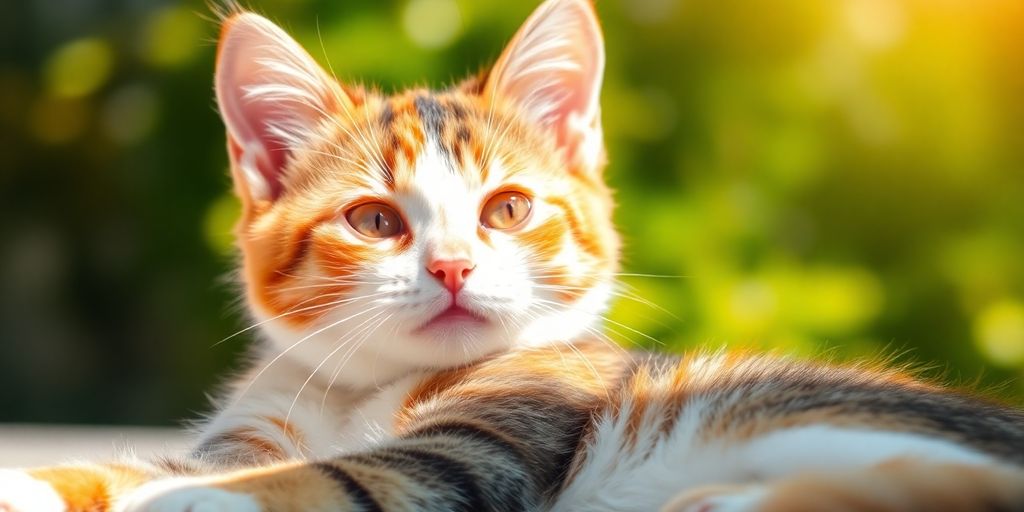Calico cats are often surrounded by myths, especially when it comes to their behavior. Some folks think they're more trouble than other cats, but is that really true? This article dives into what makes calico cats unique and whether there's any truth to these claims. From their genetics to their place in pop culture, we'll explore the ins and outs of these colorful felines.
Key Takeaways
- Calico cats aren't a specific breed; they're defined by their unique color pattern.
- The idea that calico cats are more aggressive is mostly a myth.
- Genetics play a big role in why calico cats are usually female.
- Calico cats have the same health needs as other cats, with no special dietary requirements.
- Environment and socialization can greatly influence a calico cat's behavior.
Understanding Calico Cats: A Unique Feline Phenomenon
What Makes Calico Cats Unique?
Calico cats are a fascinating bunch, and what sets them apart is their striking coat pattern. Unlike other cats, calicos sport a mix of white, black, and orange patches. This tri-color pattern isn't linked to a specific breed but rather to a genetic trait. Interestingly, the majority of calico cats are female, a fact that ties back to their unique genetic makeup. Calico cats are not a breed, but rather a color pattern that occurs in many different breeds.
The Genetics Behind Calico Cats
The calico coat pattern is a result of a genetic anomaly known as "X-inactivation." This process occurs because the genes for fur color are located on the X chromosome. Female cats have two X chromosomes, allowing for the unique calico pattern to emerge when one of the X chromosomes in each cell is randomly inactivated. Male calicos are quite rare, as they would need to possess an extra X chromosome (XXY), a condition known as Klinefelter syndrome.
Common Misconceptions About Calico Cats
There are plenty of myths surrounding calico cats, one being that they are inherently more temperamental than other cats. While some believe calicos are feistier, there's no scientific evidence to support this claim. It's also a common misconception that calico cats bring bad luck or harbor negative energy. In reality, calicos are just as loving and friendly as any other cat, and their behavior largely depends on their individual personality and environment.
Calico cats, with their vibrant coats and unique genetics, stand out in the feline world, not because they're difficult or troublesome, but because they're beautifully distinctive.
For those considering a calico as a companion, understanding their unique traits can enhance the bond you share. Platforms like Pet Genius can offer insights into their behavior and health needs, ensuring you provide the best care possible.
Behavioral Traits of Calico Cats: Myth or Reality?
Are Calico Cats More Aggressive?
Calico cats often have a reputation for being feisty and a bit more aggressive than other cats. This perception may stem from their independent and strong-willed nature. However, it's crucial to understand that not all calico cats display aggressive behavior. Like any cat, their temperament can vary widely based on individual personality and past experiences. Some calicos are indeed more assertive, while others are laid-back and gentle.
Understanding Calico Cat Temperament
When it comes to temperament, calico cats are as diverse as their coat patterns. Many owners report that their calico cats are affectionate and enjoy human interaction. These cats are known for their playful and curious nature, often exploring their surroundings with enthusiasm. It's important to note that temperament can be influenced by factors such as socialization, environment, and genetics.
Comparing Calico Cats to Other Breeds
Calico cats aren't a breed themselves but a color pattern that can appear in various breeds. This means their behavior isn't dictated by the calico pattern alone. When comparing calicos to other cats, you might notice some unique traits, but these are often more related to the breed they belong to rather than the fact that they are calico. For instance, a calico Maine Coon may exhibit different behaviors than a calico Siamese due to breed characteristics.
Calico cats, with their distinct patches of orange, black, and white, often stand out not just for their looks but also for their vibrant personalities. While some might think they're more challenging, each calico is unique, and their behavior often reflects their individual history and environment.
In summary, while calico cats can be recognized for their strong and dramatic personalities, it's not accurate to label them as inherently more problematic than other cats. Their behavior, like any cat's, is shaped by a mix of genetics, upbringing, and individual personality.
Health Considerations for Calico Cats
Common Health Issues in Calico Cats
Calico cats, known for their striking coat patterns, are often thought to have unique health issues. While their vibrant colors are eye-catching, it's important to note that their health isn't directly tied to their fur's appearance. However, some calicos, particularly those that are male, can face specific genetic health challenges. Male calicos are extremely rare and often have a condition called Klinefelter syndrome, which can lead to complications like hip dysplasia and heart disease. Regular vet check-ups are crucial to monitor and manage these potential issues.
Dietary Needs of Calico Cats
Just like any other cat, calicos need a balanced diet to thrive. A mix of high-quality proteins, fats, and carbohydrates is essential. It's also a good idea to include supplements that support joint and coat health, such as Omega-3 fatty acids. These supplements can help maintain a shiny coat and support overall well-being. Owners should consult with their vet to tailor a diet that meets their calico's specific needs.
Veterinary Care for Calico Cats
Routine veterinary care is vital for calico cats to lead healthy lives. This includes regular vaccinations, dental care, and screenings for common feline diseases. Since calicos can be prone to certain genetic conditions, more frequent health screenings might be necessary. Additionally, protecting calicos from sun exposure is important, as their lighter fur patches can be more susceptible to sunburn. Ensuring they have a safe, shaded area to relax can prevent skin issues.
Understanding the unique needs of calico cats ensures they remain happy and healthy companions. While they don't require special care just because of their coat, being aware of potential genetic issues can help in providing the best care possible.
The Role of Environment in Calico Cat Behavior
How Environment Affects Calico Cats
Calico cats, known for their striking tri-color coats, are just like any other cat when it comes to their environment. A cat's surroundings play a huge role in shaping its behavior. Factors like the amount of space they have, the presence of other pets, and even the noise level in the home can impact how a calico cat behaves. For instance, a cramped living space might make them feel stressed or anxious, while a quiet, spacious environment can promote a calm demeanor.
Socialization Tips for Calico Cats
Socializing a calico cat is not much different from socializing any other cat. Start by giving them a safe space to retreat to, especially if they're new to your home. Gradually introduce them to other pets and family members. Patience is key; let them approach you on their terms. Offering treats and engaging them in play can also help build trust and encourage social interaction.
Creating a Calico-Friendly Home
To make your home more welcoming for a calico cat, consider their need for both privacy and stimulation. Provide plenty of cozy spots where they can hide and relax. At the same time, offer toys and climbing structures to keep them entertained. A window perch can be a great addition, allowing them to observe the outside world safely. Remember, a balanced environment that caters to both their physical and mental needs is essential for a happy calico cat.
Creating a nurturing environment for your calico cat doesn't require much—just a bit of attention to their unique needs and preferences. Every cat is different, so observe what your calico enjoys and tailor their space accordingly. This way, you'll ensure they feel right at home.
Debunking Myths About Calico Cats
The Myth of the 'Difficult' Calico Cat
Calico cats often get a bad rap for being "difficult," but this claim doesn't hold much water. People tend to believe that calicos are harder to handle due to their unique coloring and supposed fiery temperament. However, this stereotype is more fiction than fact. Calico cats are just like any other cats when it comes to behavior. They don't possess any special "difficult" traits simply because of their coat color. In reality, each cat's personality is shaped by a mix of genetics, upbringing, and environment, not just their fur.
Understanding Calico Cat Behavior
Understanding calico cats means letting go of the myths and looking at the facts. These cats are not inherently more aggressive or stubborn. They are just as likely to be sweet and affectionate as any other cat. The key is to treat them as individuals rather than lumping them into a "calico" category. Like all cats, they need love, attention, and a bit of patience. If you're willing to understand their needs, you'll find that calicos can be delightful companions.
Why Calico Cats Are Not More Problematic
It's important to highlight that calico cats are not more problematic than other cats. The notion that their colorful coats bring along a bag of behavioral issues is nothing more than a widespread myth. Many cat owners will tell you that their calicos are loving and playful, not the troublemakers they're sometimes made out to be. In fact, calico and tortoiseshell cats are often perceived as sassy and strong-willed, which leads to stereotypes about their temperament. But these perceptions are just that—perceptions. Each cat is unique, and their behavior is influenced by a variety of factors beyond coat color. So, if you're considering adopting a calico, don't let the myths deter you. They're just as wonderful as any other feline friend.
Calico Cats in Popular Culture and Media
Famous Calico Cats in History
Calico cats have left their mark in history, often celebrated for their unique and striking appearance. One of the most famous calicos is Tama, the stationmaster cat in Japan. Tama's role as a stationmaster cat not only saved a local train station from financial ruin but also turned her into a national icon. Her story is a testament to the cultural significance calico cats hold in various parts of the world. In ancient Egypt, calico cats were revered and often associated with good fortune and protection.
Calico Cats in Literature and Film
Calico cats frequently appear in literature and film, often symbolizing mystery and independence. In children's books, they are portrayed as adventurous and spirited companions. Films often use calico cats to add a touch of whimsy or enchantment to the storyline. Their colorful coats make them visually appealing characters that captivate audiences of all ages.
The Cultural Significance of Calico Cats
Across different cultures, calico cats are seen as symbols of good luck and prosperity. In Japanese folklore, they are believed to ward off evil spirits, which is why they are often featured in maneki-neko, the "beckoning cat" figurines. Most calico cats are female due to their unique genetic makeup, making them even more intriguing and rare. Their presence in various cultural narratives highlights their enchanting nature and the fascination they inspire.
Adopting a Calico Cat: What to Expect
Adopting a calico cat can be an exciting journey, but it requires some preparation. Calico cats are known for being affectionate, playful, and adaptable, making them good pets. Before bringing your new feline friend home, consider the following steps:
- Research and Understand: Learn about calico cats' unique traits and personalities. This will help you set realistic expectations and provide the best care.
- Home Setup: Prepare a cozy space with all the essentials like a litter box, scratching post, and toys.
- Vet Check: Schedule a vet visit to ensure your cat is healthy and up-to-date on vaccinations.
A little preparation goes a long way in ensuring a smooth transition for both you and your new pet.
Bringing a calico cat into your home involves more than just opening the door. Here's how to make the integration process smoother:
- Slow Introduction: Allow your calico to explore their new environment gradually. Keep them in a quiet room initially, then slowly introduce them to other areas.
- Socialization: Spend time playing and interacting with your cat to build trust and a strong bond.
- Routine Establishment: Cats thrive on routine. Set regular feeding times and play sessions to help your cat adjust.
Once your calico is settled, focus on their long-term well-being. Here are some tips:
- Regular Vet Visits: Keep up with annual check-ups to monitor your cat's health.
- Balanced Diet: Provide a nutritious diet tailored to your cat's needs. Consider supplements like fish oil for skin and coat health if recommended by your vet.
- Mental and Physical Stimulation: Engage your cat with toys and activities to keep them mentally sharp and physically active.
Adopting a calico cat can be a rewarding experience. With the right preparation and care, you'll have a loving companion for years to come.
Thinking about bringing a calico cat into your home? These colorful cats are not just pretty; they have unique personalities that can bring joy to your life. Be ready for a fun adventure with your new furry friend! For more tips on caring for your pet, visit our website today!
Conclusion
So, are calico cats really more of a handful than other cats? Well, not exactly. While they might have a reputation for being a bit feisty, it's mostly just a myth. Every cat has its own personality, and calicos are no different. Some might be a little more spirited, but others can be just as laid-back as any other cat. It's all about the individual cat, not the color of their fur. So, if you're thinking about adopting a calico, don't let the myths scare you off. They're just as loving and unique as any other feline friend.
Frequently Asked Questions
What makes calico cats special?
Calico cats are special because of their three-colored fur patterns, usually a mix of white, black, and orange. These unique patterns are due to genetics, and most calico cats are female.
Are calico cats more aggressive than other cats?
No, calico cats are not more aggressive than other cats. Their behavior is similar to other cats, and any differences are usually due to individual personality rather than their fur color.
Do calico cats have any specific health issues?
Calico cats do not have specific health issues related to their color. Like all cats, they need regular vet check-ups to stay healthy.
What should I feed my calico cat?
Calico cats should be fed a balanced diet suitable for their age, size, and health. It's best to consult a vet for dietary advice specific to your cat.
Can I keep a calico cat indoors?
Yes, calico cats can be kept indoors. Providing toys and playtime can help keep them happy and active.
Are there famous calico cats in history or media?
Yes, there are famous calico cats in history and media, often celebrated for their striking appearance and unique personalities.









